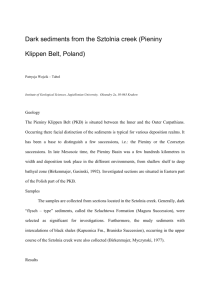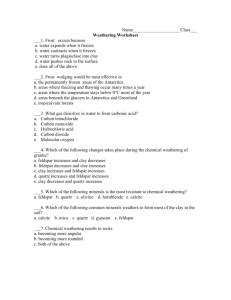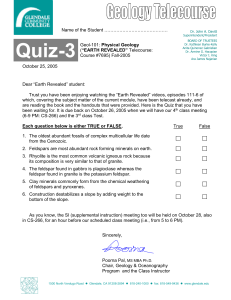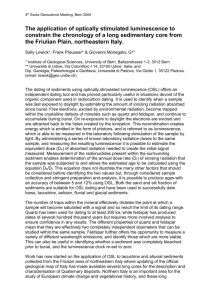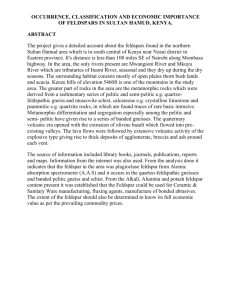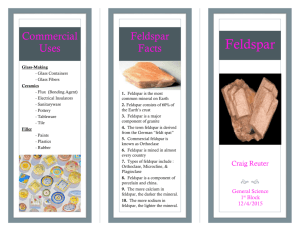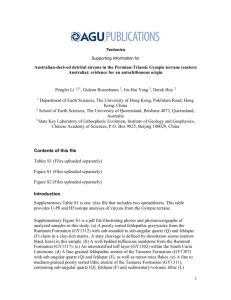Research Journal of Applied Sciences, Engineering and Technology 1(3): 140-144,... ISSN: 2040-7467 © M axwell Scientific Organization, 2009
advertisement
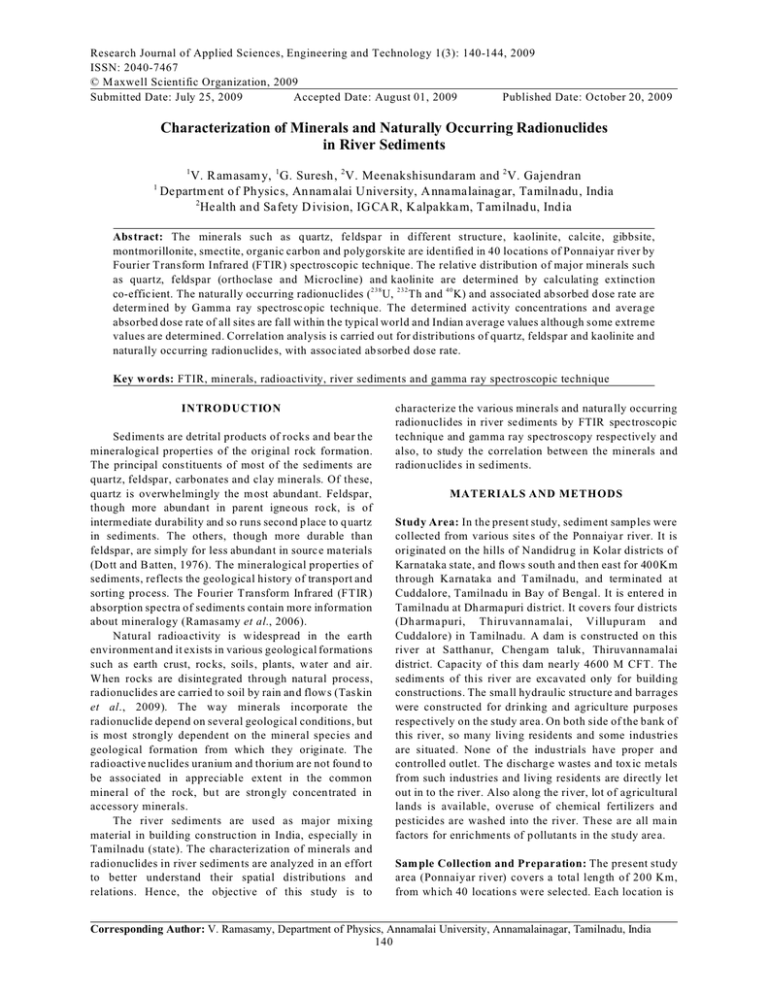
Research Journal of Applied Sciences, Engineering and Technology 1(3): 140-144, 2009 ISSN: 2040-7467 © M axwell Scientific Organization, 2009 Submitted Date: July 25, 2009 Accepted Date: August 01, 2009 Published Date: October 20, 2009 Characterization of Minerals and Naturally Occurring Radionuclides in River Sediments 1 1 V. R amasam y, 1 G. Suresh, 2 V. Meenakshisundaram and 2 V. Gajendran Departm ent of Physics, Annam alai University, A nnamalainag ar, Tamilnadu, India 2 Health an d Safety D ivision, IGCA R, K alpakkam, Tamilnadu, Ind ia Abstract: The minerals such as quartz, feldspar in different structure, kaolinite, calcite, gibbsite, montmorillonite, smectite, organic carbon and polygorskite are identified in 40 locations of Ponnaiyar river by Fourier Transform Infrared (FTIR) spectroscopic technique. The relative distribution of major minerals such as quartz, feldspar (orthoclase and Microcline) and kaolinite are determined by calculating extinction co-efficient. The naturally occurring radionuclides (2 3 8 U, 2 3 2 Th and 4 0 K) and associated ab sorbed dose rate are determ ined by Gamm a ray spectrosc opic technique. The d etermined a ctivity concentrations a nd average absorbed dose rate of all sites are fall within the typical world and Indian average values although some extreme values are determined. Correlation analysis is carried out for distributions of quartz, feldspar and kaolinite and natura lly occurring radion uclides, with assoc iated ab sorbe d dose rate. Key w ords: FTIR, minerals, radioactivity, river sediments and gamma ray spectroscopic technique INTRODUCTION Sediments are detrital products of rocks and bear the mineralogical properties of the original rock formation. The principal constituents of most of the sed iments are quartz, feldspar, carbonates and clay minerals. Of these, quartz is overwhelmingly the m ost abund ant. Feldspar, though more abun dant in parent igneous ro ck, is of intermediate durability and so runs second place to q uartz in sediments. The others, though more durable than feldspar, are sim ply for less abun dant in sourc e materials (Dott and B atten, 1976). The mineralogical properties of sediments, reflects the geological history of transport and sorting process. The Fourier Transform Infrared (FTIR) absorption spectra of sediments contain more information about mineralogy (Ramasamy et al., 2006). Natural radioactivity is w idespread in the earth environment and it exists in various geological formations such as earth crust, roc ks, soils, plants, w ater and air. W hen rocks are disintegrated through natural process, radionuclides are carried to soil by rain and flow s (Taskin et al., 2009). The way minerals incorporate the radionuclide depend on several geological conditions, but is most strongly dependent on the mineral species and geological formation from which they originate. The radioactive nuclides uranium and thorium are not found to be associated in appreciable extent in the common mineral of the rock, bu t are stron gly co ncen trated in accessory minerals. The river sediments are used as major mixing material in building co nstruction in India, esp ecially in Tamilnadu (state). The characterization of minerals and radionuclides in river sedimen ts are analyzed in an effort to better understand their spatial distributions and relations. Hence, the objective of this study is to characterize the various minerals and naturally occurring radionuclides in river sediments by FTIR spectroscopic technique and gamma ray spectroscopy respectively and also, to study the correlation between the minerals and radion uclides in sediments. MATERIALS AND METHODS Study Area: In the present study, sedim ent samp les were collected from various sites of the Ponnaiya r river. It is originated on the hills of Nandidrug in Kolar districts of Karnataka state, and flows south and then east for 400Km through Karnataka and Tamilnadu, and terminated at Cuddalore, Tamilnadu in Bay of Bengal. It is entere d in Tamilnadu at Dh arma puri district. It covers four districts (Dh arma puri, Thiruvannamalai, Villupuram and Cuddalore) in Tamilnadu. A dam is c onstructed on this river at Satthanur, Chengam taluk, Thiruvannamalai district. Capacity of this dam nearly 4600 M CFT. The sedim ents of this river are excavated only for building constructions. The small hydraulic structure and barrages were constructed for drinking and agriculture purposes respectively on the study area. On both side of the bank of this river, so many living residents and some industries are situated. None of the industrials have proper and controlled outlet. The discharg e wastes and tox ic metals from such industries and living residents are directly let out in to the river. Also along the river, lot of agricultural lands is available, overuse of chemical fertilizers and pesticides are washed into the river. These are all ma in factors for enrichme nts of pollutants in the stu dy are a. Sam ple Collection and Preparation: The present study area (Ponnaiyar river) covers a total length of 200 Km, from which 40 location s we re selec ted. Ea ch location is Corresponding Author: V. Ramasamy, Department of Physics, Annamalai University, Annamalainagar, Tamilnadu, India 140 Res. J. Appl. Sci. Eng. Technol., 1(3): 140-144, 2009 Tab le 1: The observed absorption wave numbers and corresponding minerals from F TIR sp ectra S. No. M i ne ra l N a m e Site number Observed Wave n umbers (cm G 1) 1 Qu artz S 1-S 40 460-464 514-520 S 1-S 40 S 1-S 40 693-694 S 1-S 40 777-778 S 1-S 40 794-796 S 1-S 40 1080-1084 S 1-S 40 1162-1164 S 4-S 14, S 19-S 25, S 28, S 31, S 33-S 40 1870-1883 2 Microcline Feldspar S 1-S 40 583-587 3 Orthoclase Feldspar S 1-S 40 647-650 S 1, S 3, S 15, S 21, S 23, S 29 532-537 4 Ka olinite S 1-S 40 1015-1019 S 1, S 3, S 10, S 15 1030-1037 S 6,S 10, S 15-S 19, S 24, S 32, S 35-S 36 3618-3622 S 1, S 2, S 23, S 33, S 29, S 34 3690-3691 5 Gib bsite S 1-S 40 662-670 6 Calcite S 2, S 3, S 4,S 33, S 36 1420-1438 7 M ontm orillonite S 36 878 8 Poly gorsk ite S 1, S 7, S 21, S 33, S 29, S 36 3611-3615 9 Organic Carbon S 1-S 40 2923-2929 S 1-S 40 2852-2865 10 Sm ectite S 27 523 separated by a distance of 4-5 K m ap proximately. All sediment samples were collected at 0-10 cm depth during the summer season (April-May 2008). Each sample has a weight of 3-4 kg approximately. The collected samples were dried at room temperature in open air for two days and stored in black polythen e bag s. Sample preparation and techniques FTIR: W et grinding w as carried out by placing 3 0 to 50mg of the sa mple in an agate m ortar along w ith 20 to 25 drops of ethanol. The ground samples were dried in a hot air oven at 110ºC to remove the moisture content and sieved to various grain sizes such as 74, 53 and 44:m. Using the K Br pellet techniqu e, each grain sized samp le was mixed with KBr at various ratios viz., 1:10, 1:20, 1:30, 1:40 and 1:50. The mixture was then pressed into a transparent disc in an evocable dye at sufficiently high pressure. The samples in the ratio 1:30 was taken for further analysis, since it gives rise to maximum transm ittance and observable peaks (Ramasamy et al., 2006). Using the Perkin Elmer RX1 FTIR spectrometer, the infrared spectra for all sediment sam ples were recorded in the region 4000-400 cmG 1 . The resolution of the instruments is 0.001cmG 1 and the accuracy is 4 cmG 1 . Tab le 2: T he Extinction-coefficient of Quartz, Microcline Feldspar, Orthoclase Felds par an d K aolinite o f Pon naiyar r iver sed imen ts Site Number Extinction Co-efficient ----------------------------------------------------------------------------Qu artz Microcline Orthoclase Ka olinite Feldspar Feldspar S1 92.65 26.65 8.39 1.10 S2 40.91 6.73 3.38 1.19 S3 171.82 26.83 21.11 2.29 S4 156.53 6.65 5.09 2.52 S5 77.25 13.55 5.16 2.87 S6 137.30 18.92 12.27 3.05 S7 107.01 15.58 8.6 3.10 S8 139.57 17.15 10.42 3.08 S9 95.70 18.69 6.85 3.10 S 10 147.14 34.99 19.41 3.16 S 11 110.38 6.81 8.65 3.22 S 12 107.01 17.04 10.28 3.30 S 13 92.31 15.29 8.6 3.39 S 14 62.06 8.39 6.81 3.17 S 15 153.10 29.83 17.48 3.73 S 16 127.93 6.65 15.58 3.82 S 17 49.35 20.58 5.09 3.22 S 18 112.09 46.43 10.35 3.92 S 19 210.10 24.02 23.09 4.88 S 20 106.21 37.10 10.35 4.25 S 21 165.43 27.45 20.84 4.01 S 22 111.24 8.39 11.96 4.03 S 23 70.63 11.82 5.92 4.03 S 24 132.11 42.84 10.55 4.09 S 25 275.75 8.33 27.36 4.19 S 26 47.67 20.45 5.06 4.24 S 27 127.23 29.64 13.89 4.25 S 28 141.86 6.65 13.72 4.32 S 29 45.98 22.23 5.09 4.33 S 30 112.93 4.99 12.04 4.42 S 31 171.82 8.44 15.68 4.48 S 32 71.64 25.82 5.12 4.57 S 33 159.21 5.19 13.98 4.68 S 34 108.66 24.17 10.42 4.69 S 35 181 .5 717.26 17.93 4.79 S 36 35.68 10.03 5.09 5.01 S 37 88.88 13.38 8.65 4.95 S 38 71.13 8.28 6.81 4.97 S 39 66.3 16.65 5.09 5.07 S 40 78.36 10.25 6.85 5.16 Gamma ray spectroscopic technique: The samples were dried in an oven 110ºC till the constant dry weight was obtained, crushed and homogenized. The homogenized samples were packed in a 250 ml plastic container (9cm x 6.5cm: Height x Diameter) to its full volume w ith uniform mass. These containers shielded hermetically and also shielde d externally to ensure that all daughter products of uranium and thorium, in particular, radon isotope formed, do not escape. A time of four weeks was allowed after packing to attain secular equilibrium between Ra-226 and its short-lived daughter products. The net weight of the sample w as determine d before counting. The gamma ray spectrometer with NaI(TI) detector was used to determ ine the concentration of primordial radionuclides ( 2 3 8 U, 2 3 2 Th and 4 0 K). T he de tector was shielded by 15 cm thick lead on all four sides and 10 cm thick on top . The energ y resolution of 2.0 Kev and relative efficiency of 33% at 1.33Mev was achieved in the system with the counting time of 10000 seconds. The Standard International Atomic Energy Agency (IAEA) sources were used for calibration. From the counting spectra, the activity concen trations of 2 3 8 U, 2 3 2 Th and 4 0 K was determined using computer program. The peak corresponds to 1460K ev (K-40) for 4 0 K, 1764.5 Kev (Bi214) for 2 3 8 U and 2614.5Ke v (Ti-208) for 2 3 2 Th w ere considered in arriving at the activity levels (Bq/kg). RESULTS calcite, gibbsite, mon tmorillonite, smectite, org anic carbon and polygorskite are identified by comparing the observed wave numbers with available literatures (Russell 1987 and Ramasamy et al., 2004, 2005 & 2 006). The FTIR spectra were recorded for all samples. The observed absorption wave numbers are tabulated w ith corresponding minerals in Table 1. The minerals such as quartz, microcline feldspar, orthoclase feldspar, kaolinite, 141 Res. J. Appl. Sci. Eng. Technol., 1(3): 140-144, 2009 Fig 1: Co ncentration of 238 U, 232 Th, 40 U and Absorbed dose rate of all sites D= (0.462C U + 0.604 C T h +0.0417 C K ) nGyhG 1 Extinction co-efficient of Quartz, Feldspar and Kaolinite: W ith reference to the number of peaks and intensity, the minerals such as quartz, feldspar and kaolinite are consider as major. The other mine rals are accessory. The relative distribution can be quantified by calculating the extinction co-efficient for the characteristic peaks quartz, orthoclase feldspar, microcline feldspar and kaolinite at around 778 , 647, 585 and 1015 cmG 1 respectively for all sites using the formula (Ramasamy et al., 2006). From the calculated va lues (Table 2), maximum extinction co-efficient values for quartz, orthoclase feldspar, microcline feldspar and kaolinite are 275.75, 46.43 an d 5.16 in the site n o. S 2 5 , S 1 8 and S 4 0 respectively. In the same way, minimum values are 35.68, 6.65 and 1.10 are in the site no. S 3 6 , S 2 8 and S 1 respectively. W here D is the absorbed dose rate (nGyh G1 ), C U , C T h and C K are the activity concentrations (B q/kg) of 2 3 8 U, 232 Th and 4 0 K in river sediments respectively. The range of absorbed dose rates is from 14 .72nGy/h to 88.95 nGy/h with average of 47.07nGy/h. DISCUSSION Quartz is common and invariably present in all samples. The presence of quartz in the samples can be explained by Si-O asymmetrical bending vibrations around 464 cmG 1 , Si-O symmetrical bending vibrations around 694 cmG 1 , Si-O symmetrical stretching vibrations at around 778 and 796 cmG 1 , while the 1082 and 1162 cmG 1 absorption region arises from Si-O asymmetrical stretching vibrations due to low Al for Si substitution. These assignments are in good agreement with the observation on the quartz mineral obtained by Ramasamy et al., 2006. Feldspar is also freque nt con stituents in sediments. The peak corresponding the range 583-587 cmG 1 is due to the O-Si-(Al)-O bending vib ration for microcline an d in the ranges 647-650 cm G1 are due to the Al-O coordination vibrations indicates the presence of orthoclase feldspar. Kaolinite is the clay mineral. The presence of band near 3620 cmG 1 arises from internal OH group and that near 3690 cmG 1 arises from internal surface OH group (Russell 1987; Ramasamy et al., 2006). The band near 1015 cmG 1 is present in all the sites indicates the presence of Kao linite (Russell 1987). Activity Con centration of 2 3 8 U, 2 3 2 Th and 4 0 K: The activity concentration of natural radionuclides (2 3 8 U, 2 3 2 Th and 4 0 K) for all samples is determined and is sh own in Fig. 1. It varies from site to site, because river bottoms can exhibit large variation in chemical and mineralogical properties (Krma r et al., 2009). The mean activity concentration ranges for 2 3 8 U, 2 3 2 Th and 4 0 K are BDL 11.60±6.13Bq/kg with an average 7.31 ± 3.41Bq/kg, BDL - 106.11 ± 9.20Bq/kg with an average 46.85 ± 5.25Bq/kg and 201.23 ± 19.90 - 467.7 1 ± 34.34Bq/kg w ith an average 384.03±26.82Bq/kg respectively. Absorbed Dose rate: The mean activity concentrations of 2 3 8 U, 2 3 2 Th and 4 0 K are con verted in to dose rate based on the conversion factor given by UNSC EAR (2000) and El-G ama l et al., (2007)(Fig. 1). 142 Res. J. Appl. Sci. Eng. Technol., 1(3): 140-144, 2009 .Table 3: Correlation analysis of E xtinction coeffic ient of Quartz, Microcline Feldspar, Orthoclase F eldspar and Kaolinite and concentration of Rad ionuc lides of P onn aiyar rive r sedim ents 238 U 232 40 ADR E-Q E-MCF E - O C F E -K A Th K 238 U 1 232 T h -0.623 1 40 K -0.769 0.818 1 A D R -0.638 0.999 0.847 1 E-Q -0.107 -0.089 -0.076 -0.093 1 E - M C F -0.098 -0.118 -0.061 -0.118 0.116 1 E - O C F -0.132 -0.046 0.013 -0.044 0.90 10.221 1 E -K A -0.822 0.852 0.922 0.869 0.075 -0.0050. 137 1 238 U, 232Th and 40K a re th e c on ce nt ra ti on s o f n at ur al ra di on u cl id es (B q /K g ). A DR – Absorbed D ose r at e ( n G y/ h) . E - Q - E x ti nc ti on c o- ef fi ci en t o f Q ua rt z. E -M C F Extinction co-efficient of Microcline Feldspar. E- OCF- Extinction co-efficient of Orthoclase Feldspar and E-KA - Extinction co-efficient Kaolinite. Calcite is the most com mon c arbonate m ineral in sediments. From the existence of a peak in the range 1420-1438 cmG 1 it is easily recog nized that the calcite is present in site no . S 2 -S 4 , S 3 3 and S 3 6 . The existenc e of a peak near 665, 878, 523, 2925 &2855 and 3612 cmG 1 respe ctively indicate that presence of gibbs ite, montmorillonite, sme ctite, organic Carbon and polyg orskite. From extinction co-efficient values, the amount of kaolinite is very much lesser than quartz and lesser than orthoclase and m icrocline feldspar. In all sampling sites, mean activity concentration of natura lly occurring radio nuclides is of the order 2 3 8 U< 232 Th < 4 0 K. In particular S 2 , the activity concentration of 238 U is high, w hich m ay be due to the solubility and mob ility of U (VI)O 2 2 + (Pow ell et al., 2007). However, the S 4 0 is having hig h activity concentrations. Increasing concentration of 2 3 2 Th and 4 0 K may be due to the high content of monazite (Orgun et al., 2007). The increasing trend of 4 0 K is due to presence of clay sed imen ts (ElGamal et al., 2007) The concen tration of 2 3 8 U, 2 3 2 Th and 4 0 K for all measured samples are below the world and Indian average values (World average value of 2 3 8 U, 2 3 2 Th and 4 0 K is 33Bq/kg, 45 Bq/kg and 420Bq/kg respectively. Indian average value of 2 3 8 U, 2 3 2 Th and 4 0 K is 28.67 Bq/kg, 63.83 Bq/kg and 327.6 Bq/kg respectively). However in some sampling sites, concentration of 2 3 2 Th is h igher than w orld average value, indicating that clay m ineral m ay ex ist at that sampling site. Ramasamy et al., 2004a & 2006a reported the values of Palaru and Cauvery rivers, which are higher than the present values. Average absorbed dose rate for all samples are lower than the world average value (55n Gy/h) (U NSC EA R 2000). value, although some extreme values have been determined. The Ponnaiyar river sediments have insignificant radiological hazards. The obtained positive correlation (r = 0.87) between the distribution of kaolinite(clay minerals) and absorbed dose rate shows that, clay minerals like kaolinite may act as a booster of level of radioactivity. ACKNOWLEDGEMENT The autho rs are tha nkful to the D irector, IGCAR and Head, HASD , IGCAR, Kalpakkam, Tamilnadu, for permission to use the facilities. REFERENCES Dott, R.H ., R.L. B atten, 1976. Evolution of the Earth, second edition, Mc Graw H ill Book Company, Newdelhi. El-G ama l, A., S. Nasr and A.El-Taher, 2007. Study of the spatial distribution of na tural radioactivity in Upper Egypt Nile River sediments. Radiat. Meas., 42: 457-465. Krm ar, M., J. Slivka, E. Varga, I. Bikit, M. Veskovic, 2009. Correlations of natural radionuclides in sediment from Danube. J. Geochem . Explor., 100(1): 20-24. Orgun, Y., N . Altinso y, S.Y . Sahin, Y. Gungor, A.H. Gultekin, G. K araha m an d Z. Karaak, 2007.Natural and anthro pogenic radionu clides in rocks and beach sands from E zine region(cana kkale), W estern Anatolia, Turkey. Appl. Radiat. Isotop., 65: 739-747. Pow ell, B.A ., L.D. Hughes, M .A. Soreefan, Deborah Falta., Michaal Wall and T.A. Devol, .2007. Elevated concentrations of primo rdial radionuc lides in sediments from the Re edy river and surro unding creeks in Simpson ville, South Carolina. J. Environ. Radioactiv., 94: 121-128. Ramasamy, V., S. Murugesan, and S. Mullainathan, 2004. Charac terization of minerals and relative distribution of quartz in Cau very river sed iments from Tamilnadu, India- A FTIR study. Bu ll. Pure Appl., Sci. 23(1-2): 1. Ramasamy, V., S. Murugesan, S. Mullainathan, 2004. Gamma ray spectrometric analysis of primordial radionuclides in sedimen ts of Cauv ery river in Tamilnadu, India. The Ekologia, 2(1-2): 83-88. Correlation analysis: In order to determine inter- relation between the minerals and concentrations of radionuclides in the sediments, Pearson correlation analysis is carried out using SPS S for w indow s 16.0 softw are, and is shown in Table 3 as the linear correlation matrix. From the correlation analysis, the distribution of quartz and feldspar are poorly correlated with individu al activities of 2 3 8 U, 2 32 Th and 4 0 K and absorbed dose rate (Table 3). But the distribution of Kaolinite (clay min erals) is well positively correlated with individua l activities of 2 3 2 Th and 4 0 K and absorbed dose rate (T able 3). CONCLUSION From the FT IR study, the minerals such as quartz, feldspar (orthoc lase an d feldspar) an d kao linite are as major minerals. Others such as calcite, gibbsite, smectite, montmorillonite, polyg orskite and o rganic carbons are as accessory minerals in Ponnaiyar river sediments. The calculated extinction co-efficient values show that, the amount of qua rtz is greater than feldspar (orthoclase and feldspar) and very much greater than kaolinite in all the sites. The average activity concentrations of Ponnaiyar river sediments were within the world and Indian average 143 Res. J. Appl. Sci. Eng. Technol., 1(3): 140-144, 2009 Ramasamy, V., S. M urugesan and S . Mullainathan, 2005. Distribution and characterization of minerals in Cauvery river sediments by grain size analysis –A new approach by FTIR study. The Ind. M iner., 39(2): 91. Ramasamy, V., P. Rajkumar and V. Ponnusamy, 2006. FTIR spectroscopic analysis and mineralogical characterization of Vellar river sedimen ts. Bull. Pure Appl. Sci., 25(1): 49-55. Ramasamy, V., S. Murugesan and S. Mullainathan, 2006. Natural activity concentration and radiological hazards of Palar river sediments, Tamilnadu, India. The Ind. Miner., 40(1): 9-23. Russell, J.D., 1987. Infrared methods – A hand book of determinative methods in clay mineralogy, Ed.by W ilson MJ, Blackie and Son Ltd., New York, 133. Taskin, H., M. Karavus, P. Ay, A. Topuzoglu, S. Hindiroglu and G. Karahan, 2009. Radionuclide concentrations in soil and lifetime cancer risk due to the gamma radioactivity in Kirklareli, Turkey. J. Environ. Radioactiv., 100: 49-53. United Nations Scientific Committee on the Effect of Atomic Rad iation. R eport to the general assembly. Annex B: exposures from natural radiation sources. (UN SCE AR 2000). 144
